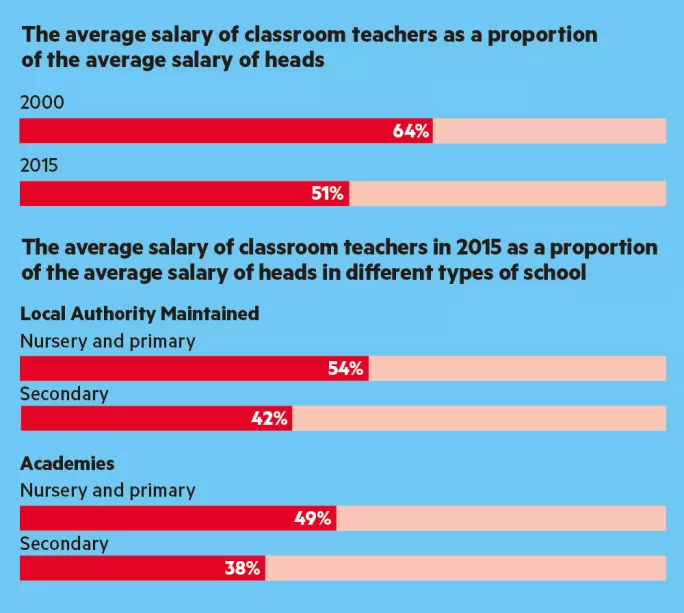Pay gap between leaders and teachers widens

A stark and growing pay gap between heads and classroom teachers has been uncovered by a TES analysis.
Teaching unions see the trend as evidence of growing “pay inequality” and say it is due to greater flexibility over pay and the rise of academies. However, heads point to the increasing demands of leadership posts as a justification for higher salaries.
The news comes as TES reveals that the salaries of some multi-academy trust leaders have increased significantly - in one case almost doubling in a year.
In 2000, the average salary of classroom teachers in England and Wales was £23,980 - 64 per cent of the £37,520 average salary of headteachers.
But by 2015 (when the Department for Education collected the figures for England only), classroom teachers in state-funded schools earned just 51 per cent of the average pay of headteachers. This meant they took home £34,600 on average, compared with the £67,300 received by heads.
The academy effect
The pay gap is even larger in the secondary sector. In 2015, the biggest salary disparity was in secondary academies, where classroom teachers earned £35,500 on average - which amounted to just 38 per cent of the £92,900 average pay of headteachers.
In secondary maintained schools, classroom teachers earned 42 per cent of the £87,600 earned by their heads.
For both types, the gap was significantly bigger than in 2000, when secondary teachers received 52 per cent of heads’ pay.
In the primary sector, there appears to be a smaller pay gap, although the disparity is again bigger for academies.
In 2015, maintained nursery and primary classroom teachers were paid 54 per cent of the amount that heads received, but in primary academies the figure was 49 per cent.
Greater freedom appears to be exacerbating pay inequality
Overall, teachers’ pay has risen by 44 per cent in cash terms in the past 15 years, compared with 79 per cent for heads, according to the data - which included part-time workers in 2015 but not in 2000.
Unions have highlighted the issue of growing “pay inequality” between classroom teachers and school leaders in recent years, linking the phenomenon to schools having greater flexibility over wages since the removal of pay scales and the introduction of performance pay progression in 2013.
In its submission to the School Teachers’ Review Body for the 2016-17 pay round, the NASUWT teaching union said: “Greater freedom and autonomy on pay matters appears to be exacerbating pay inequality, driving up the pay of the most senior employees and depressing the pay of the lowest paid.”
The DfE stopped reporting information on heads’ pay between 2010 and 2014, but the data since then suggests that it has been growing faster than that of classroom teachers.

Between 2014 and 2015, the pay of teachers in state-funded schools grew by just £300 on average, but for heads it increased by £1,300.
Dave Wilkinson, a national negotiating official at the NASUWT, said that while his union was in favour of school leaders being paid “fairly”, the growing pay gap between classroom teachers and heads “causes concern”.
Academisation had widened the gap because academy trusts did not have to apply statutory guidance on school teachers’ pay and conditions, he added, resulting in some heads receiving “disproportionate and inappropriately high levels of pay”.
Leadership a ‘demanding role’
Kevin Courtney, general secretary of the NUT teaching union, said that pay flexibility had pushed up the pay of some, but not all, headteachers. “Some have been denied any pay increase while others have clearly benefited from it,” he added.
However, Russell Hobby, general secretary of the NAHT headteachers’ union, defended the increasing gap, highlighting the fact that some heads now ran several schools.
He added: “The job of school leadership is demanding and highly accountable, and the gap in pay between leaders and their workforce is much smaller in education than in most other sectors.”
A DfE spokeswoman said: “It is vital we have the best people to lead our schools if we are to raise standards and ensure all pupils can reach their full potential.
“That’s why we have given all schools greater flexibility to set staff pay, reward exceptional leaders and attract strong leadership teams to work in the most challenging schools. It is for governing bodies to determine salaries.”
You need a Tes subscription to read this article
Subscribe now to read this article and get other subscriber-only content:
- Unlimited access to all Tes magazine content
- Exclusive subscriber-only stories
- Award-winning email newsletters
Already a subscriber? Log in
You need a subscription to read this article
Subscribe now to read this article and get other subscriber-only content, including:
- Unlimited access to all Tes magazine content
- Exclusive subscriber-only stories
- Award-winning email newsletters